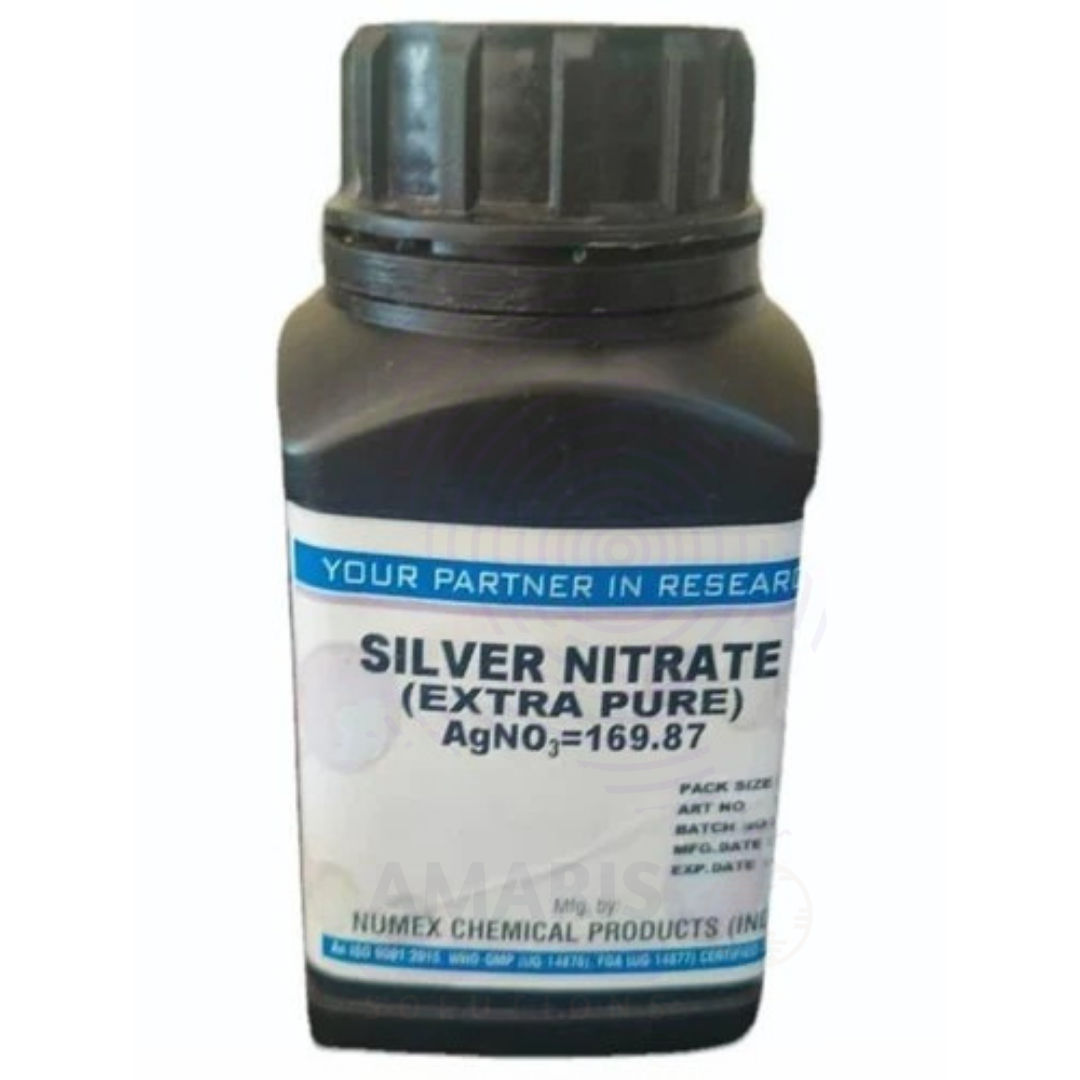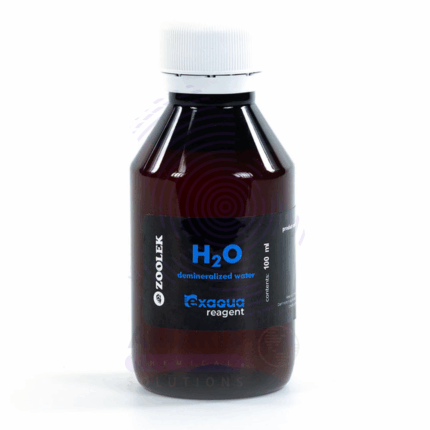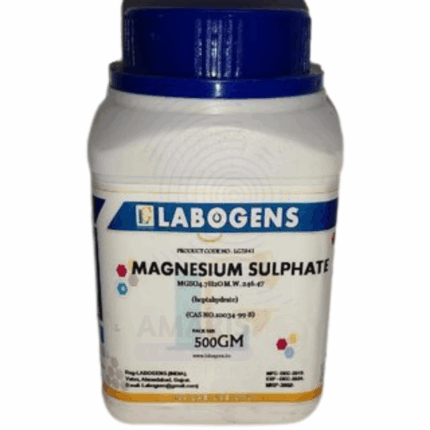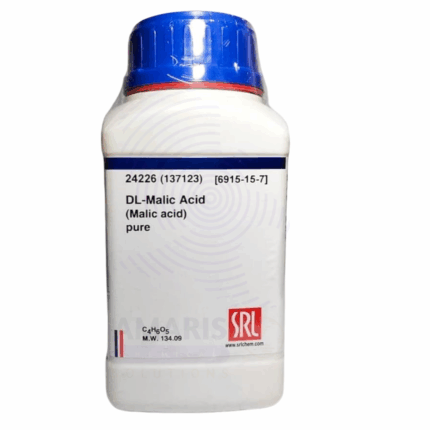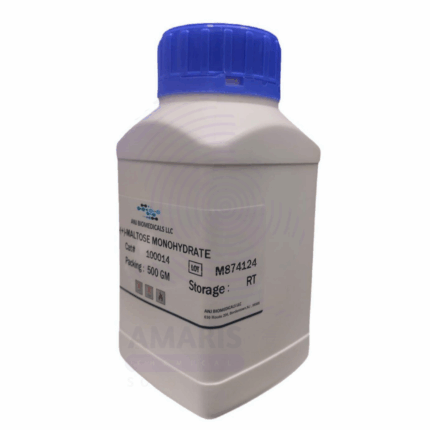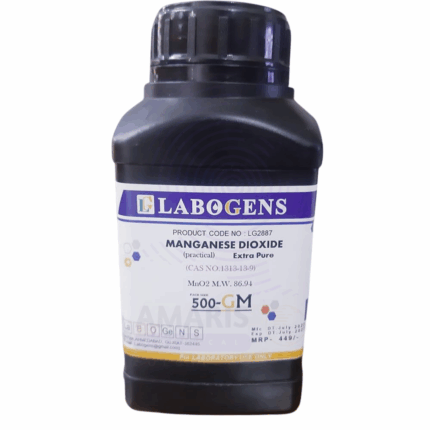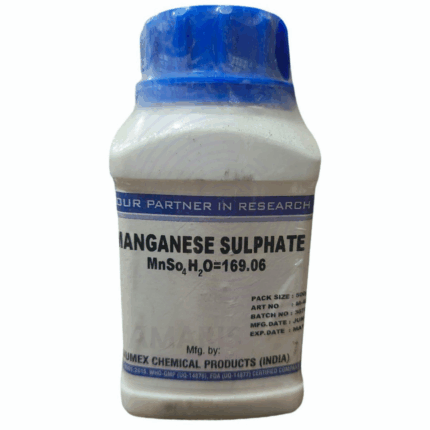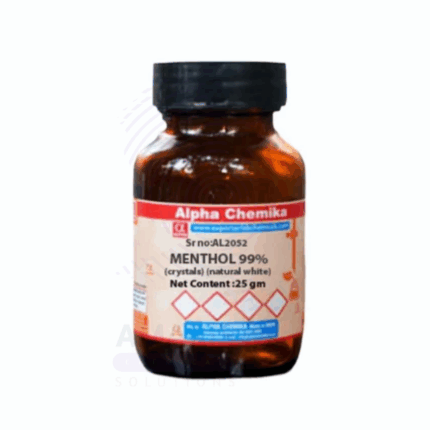“Manganese Dioxide Extra Pure” has been added to your cart. View cart
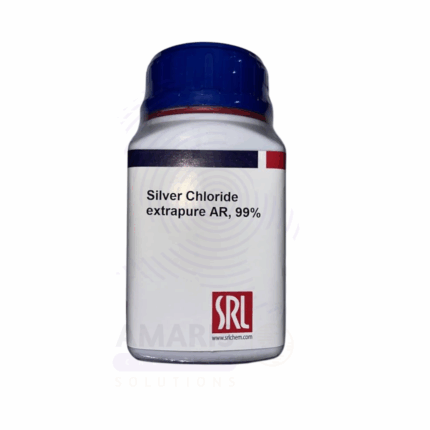
Silver Chloride Extra Pure
$ 25.00 Original price was: $ 25.00.$ 24.76Current price is: $ 24.76.
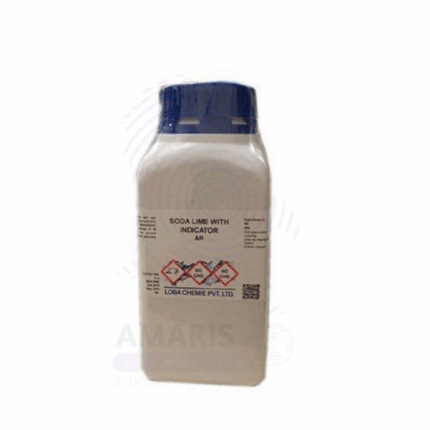
Sodalime With Indicator Extra Pure
$ 21.00 Original price was: $ 21.00.$ 20.17Current price is: $ 20.17.
Silver Nitrate Extra Pure
$ 21.00 Original price was: $ 21.00.$ 20.54Current price is: $ 20.54.
Whatsapp Order
Silver Nitrate Extra Pure is a high-purity, colorless to white crystalline solid widely used in analytical chemistry, medical treatments, and photography. Known as lunar caustic, it serves as a key reagent for detecting halides and as an antiseptic agent. Its high solubility in water and sensitivity to light requires careful storage in dark, sealed containers. The Extra Pure grade ensures minimal impurities for precision work.
Description
Table of Contents
Toggle
Silver Nitrate Extra Pure
PRIMARY USES
- Analytical Reagent & Laboratory Applications:
- Used as a standard reagent for quantitative chemical analysis.
- Employed in titrations to detect halides, thiocyanates, and cyanides.
- Used to prepare other silver compounds and in qualitative inorganic analysis.
- Medical & Pharmaceutical Applications:
- Utilized as a cauterizing agent in wound care and treatment of skin conditions.
- Employed in antiseptic solutions and to prevent infections.
- Photography & Imaging:
- Used in photographic emulsions and light-sensitive materials.
SECONDARY USES
- Water Treatment:
- Acts as a biocide to control microbial growth in water systems.
- Catalysis & Chemical Synthesis:
- Serves as a catalyst or precursor in organic and inorganic synthesis.
- Serves as a catalyst or precursor in organic and inorganic synthesis.
PRODUCT KEY FEATURES
-
Basic Identification Attributes
- Chemical Name: Silver Nitrate
- CAS Number: 7761-88-8
- HS Code: 2843.10.00
- Molecular Formula: AgNO₃
- Synonyms: Argent Nitrate, Lunar Caustic
-
Physical & Chemical Properties
- Physical State: Solid (crystalline or granular)
- Color & Odor: Colorless to white, odorless
- Density/Specific Gravity: 4.35 g/cm³
- Solubility: Highly soluble in water (~256 g/L at 20 °C), soluble in ethanol
- Melting Point: 212 °C (decomposes)
- pH Level: Acidic in aqueous solution
- Flash Point: Not flammable
-
Safety & Hazard Attributes
- Hazard Class (GHS Classification):
- Acute toxicity (Category 4)
- Skin corrosion/irritation (Category 1B)
- Eye damage (Category 1)
- Specific target organ toxicity (repeated exposure)
- NFPA Ratings: Health 3, Flammability 0, Reactivity 1
- Exposure Limits: No specific OSHA PEL, use general dust precautions
- Reactivity: Sensitive to light and heat; decomposes releasing toxic fumes
- Hazard Class (GHS Classification):
-
Storage & Handling Attributes
- Store in a cool, dry, dark place, protected from light and moisture
- Keep container tightly closed in amber or opaque bottles
- Avoid contact with reducing agents and combustible materials
- Shelf life: Stable if stored properly
-
Regulatory & Compliance Attributes
- Listed under REACH, TSCA, and other inventories
- Classified as hazardous for transport (oxidizer)
- Dispose of according to environmental regulations
-
Environmental & Health Impact
- Toxic to aquatic organisms with long-lasting effects
- Handle with care to prevent environmental contamination
- Not classified as carcinogenic
SAFETY HANDLING PRECAUTIONS
SAFETY PRECAUTIONS
- Personal Protective Equipment (PPE):
- Use gloves, safety goggles, and protective clothing
- Employ respiratory protection if dust or fumes are generated
- Handling:
- Avoid inhalation, ingestion, and contact with skin and eyes
- Handle in well-ventilated areas
- Wash hands after handling
- Storage:
- Store away from light, heat sources, and incompatible substances
- Keep containers tightly sealed
FIRST AID MEASURES
- Inhalation:
- Move person to fresh air immediately
- Seek medical attention if symptoms develop
- Skin Contact:
- Rinse affected area with plenty of water
- Remove contaminated clothing
- Seek medical advice if irritation occurs
- Eye Contact:
- Rinse eyes thoroughly with water for at least 15 minutes
- Seek immediate medical attention
- Ingestion:
- Rinse mouth with water
- Do not induce vomiting unless directed
- Seek medical attention promptly
FIRE FIGHTING MEASURES
- Flammability:
- Non-flammable but oxidizing agent
- Extinguishing Media:
- Use water spray, foam, or dry chemical extinguisher
- Hazardous Combustion Products:
- May release toxic silver and nitrogen oxides on decomposition
- Firefighter Protection:
- Use self-contained breathing apparatus and full protective gear
- Use self-contained breathing apparatus and full protective gear
Related products
Barium Nitrate
Barium Nitrate is an inorganic chemical compound, a white crystalline solid composed of barium and nitrate ions. It is highly soluble in water and serves as an oxidizing agent. Due to its energetic properties, barium nitrate is widely used in pyrotechnics to produce vibrant green colors and as an oxidizer in explosives and fireworks. It is also utilized in the manufacturing of barium oxide and other barium compounds. Barium nitrate must be handled carefully due to its toxicity and oxidizing nature.
Deionized Water Extra Pure
Deionized Water Extra Pure is ultra-purified water that has had all mineral ions, such as sodium, calcium, iron, chloride, and sulfate, removed through ion-exchange processes. It is widely used in laboratories as a solvent, reagent diluent, and cleaning agent for sensitive instruments, ensuring no interference from dissolved ions in chemical analyses or reactions. This extra pure grade guarantees extremely low conductivity and minimal contaminants, making it ideal for analytical procedures, biological experiments, and preparation of standard solutions. It should be stored in clean, non-leaching containers to maintain its purity and prevent recontamination.
Magnesium Sulphate Extra Pure
$ 17.20
Magnesium Sulphate Extra Pure is a high-purity, inorganic compound commonly appearing as a white crystalline powder or granules. It is primarily valued in laboratories for its role as a source of magnesium ions in chemical analysis and biological experiments. This compound is widely used in buffer preparation, dehydration processes, and precipitation reactions due to its excellent solubility in water. In addition to lab applications, it also serves purposes in pharmaceutical formulations, cosmetics, and agriculture as a magnesium supplement. Its extra pure grade ensures minimal impurities, making it suitable for sensitive research and analytical tasks.
Malic Acid Extra Pure
Malic Acid Extra Pure is a high-grade, naturally occurring dicarboxylic acid known for its sharp, tart flavor and versatility in both laboratory and industrial settings. It is commonly found in fruits such as apples and is widely used as an acidulant in food and beverage formulations, where it enhances flavor, preserves freshness, and improves pH stability. In laboratory applications, Malic Acid is employed in biochemical research, particularly in studies involving the citric acid cycle, due to its role as an intermediate metabolite. Its excellent solubility in water and mild acidity also make it suitable for cosmetic formulations and pharmaceutical preparations. The extra pure grade ensures high analytical accuracy and consistent quality across applications requiring strict purity standards.
Maltose Extra Pure
Maltose Extra Pure is a disaccharide composed of two glucose units, commonly known as malt sugar. This extra pure grade ensures exceptional quality and consistency, making it ideal for use in biochemical research, fermentation studies, and laboratory analysis. In the food industry, maltose is valued for its mild sweetness and is often used in brewing, baking, and confectionery to promote fermentation and enhance flavor. It also plays a role in energy metabolism studies and is frequently used as a carbon source in microbiological media. Its stability and solubility in water make it easy to incorporate into various formulations, offering a dependable ingredient for scientific and industrial use where high purity is essential.
Manganese Dioxide Extra Pure
Manganese Dioxide Extra Pure is a high-purity, dark brown or black powder widely used in laboratories and industrial processes for its strong oxidizing properties. In analytical chemistry, it serves as an effective oxidizing agent and is often involved in the decomposition of hydrogen peroxide and other redox reactions. It is also used in the preparation of oxygen and chlorine gases in laboratory settings. Beyond the lab, manganese dioxide plays a crucial role in battery manufacturing, particularly in dry cell batteries, and in ceramics and glass production for coloring and decolorizing. Its consistent purity makes it ideal for sensitive experiments and formulations.
Manganese Sulphate Extra Pure
Manganese Sulphate Extra Pure is a highly refined, pale pink crystalline compound widely valued for its use in both laboratory and industrial applications. In the lab, it serves as a reliable source of manganese ions in analytical chemistry, synthesis of manganese-based catalysts, and as a micronutrient in biological research. Industrially, it plays a crucial role in fertilizers, where it addresses manganese deficiency in crops, and in animal feed formulations. Due to its high solubility and purity, this compound is also used in electroplating, ceramics, and pigment production, making it a versatile and essential chemical in many scientific and manufacturing settings.
Menthol Crystals Extra Pure
Menthol Crystals Extra Pure are colorless to white, needle-like crystals derived from peppermint or other mint oils and refined to the highest purity. Known for their strong, refreshing minty aroma, they are widely used in pharmaceutical, cosmetic, and personal care formulations. These crystals provide a cooling sensation on the skin and mucous membranes, making them a common ingredient in balms, liniments, throat lozenges, and inhalants. In laboratories, menthol crystals are also used in sensory studies and product development. Their purity ensures consistent performance and minimal interference in sensitive formulations.


 Preservatives(food)
Preservatives(food) Flavor Enhancers
Flavor Enhancers Acidulants
Acidulants Sweeteners
Sweeteners Antioxidants
Antioxidants Colorants(food)
Colorants(food) Nutraceutical Ingredients (food)
Nutraceutical Ingredients (food) Nutrient Supplements
Nutrient Supplements Emulsifiers
Emulsifiers
 Collectors
Collectors Dust Suppressants
Dust Suppressants Explosives and Blasting Agents
Explosives and Blasting Agents Flocculants and Coagulants
Flocculants and Coagulants Frothers
Frothers Leaching Agents
Leaching Agents pH Modifiers
pH Modifiers Precious Metal Extraction Agents
Precious Metal Extraction Agents
 Antioxidants(plastic)
Antioxidants(plastic) Colorants (Pigments, Dyes)
Colorants (Pigments, Dyes) Fillers and Reinforcements
Fillers and Reinforcements Flame Retardants
Flame Retardants Monomers
Monomers Plasticizers
Plasticizers Polymerization Initiators
Polymerization Initiators Stabilizers (UV, Heat)
Stabilizers (UV, Heat)
 Antifoaming Agents
Antifoaming Agents Chelating Agents
Chelating Agents Coagulants and Flocculants
Coagulants and Flocculants Corrosion Inhibitors
Corrosion Inhibitors Disinfectants and Biocides
Disinfectants and Biocides Oxidizing Agents
Oxidizing Agents pH Adjusters
pH Adjusters Scale Inhibitors( water)
Scale Inhibitors( water)
 Antioxidants(cosmetic)
Antioxidants(cosmetic) Emollients
Emollients Fragrances and Essential Oils
Fragrances and Essential Oils Humectants
Humectants Preservatives
Preservatives Surfactants(cosmetic)
Surfactants(cosmetic) Thickeners
Thickeners UV Filters
UV Filters
 Fertilizers
Fertilizers Soil Conditioners
Soil Conditioners Plant Growth Regulators
Plant Growth Regulators Animal Feed Additives
Animal Feed Additives Biostimulants
Biostimulants Pesticides (Herbicides, Insecticides, Fungicides)
Pesticides (Herbicides, Insecticides, Fungicides)
 Active Pharmaceutical Ingredients (APIs)
Active Pharmaceutical Ingredients (APIs) Excipients
Excipients Solvents(pharmaceutical)
Solvents(pharmaceutical) Antibiotics
Antibiotics Antiseptics and Disinfectants
Antiseptics and Disinfectants Vaccine Adjuvants
Vaccine Adjuvants Nutraceutical Ingredients (pharmaceutical)
Nutraceutical Ingredients (pharmaceutical) Analgesics & Antipyretics
Analgesics & Antipyretics
 Analytical Reagents
Analytical Reagents Solvents(lab)
Solvents(lab) Chromatography Chemicals
Chromatography Chemicals Spectroscopy Reagents
Spectroscopy Reagents microbiology-and-cell-culture-reagents
microbiology-and-cell-culture-reagents Molecular Biology Reagents
Molecular Biology Reagents Biochemical Reagents
Biochemical Reagents Inorganic and Organic Standards
Inorganic and Organic Standards Laboratory Safety Chemicals
Laboratory Safety Chemicals Specialty Laboratory Chemicals(Special Laboratory Equipment)
Specialty Laboratory Chemicals(Special Laboratory Equipment)
 Demulsifiers
Demulsifiers Hydraulic Fracturing Fluids
Hydraulic Fracturing Fluids Scale Inhibitors(oil)
Scale Inhibitors(oil) Surfactants(oil)
Surfactants(oil) Drilling Fluids
Drilling Fluids
 Dyes and Pigments
Dyes and Pigments Bleaching Agents
Bleaching Agents Softening Agents
Softening Agents Finishing Agents
Finishing Agents Antistatic Agents
Antistatic Agents
 Admixtures
Admixtures Waterproofing Agents
Waterproofing Agents Sealants and Adhesives
Sealants and Adhesives Curing Compounds
Curing Compounds Concrete Repair Chemicals
Concrete Repair Chemicals Anti-Corrosion Coatings
Anti-Corrosion Coatings
 Surfactants(cleaning)
Surfactants(cleaning) Builders
Builders Enzymes
Enzymes Solvents (Cleaning)
Solvents (Cleaning) Fragrances
Fragrances
 Electronic Chemicals
Electronic Chemicals Catalysts
Catalysts Lubricants
Lubricants Photographic Chemicals
Photographic Chemicals Refrigerants
Refrigerants Automotive chemicals
Automotive chemicals Pyrotechnic Chemicals
Pyrotechnic Chemicals
 Biodegradable Surfactants
Biodegradable Surfactants Bio-based Solvents
Bio-based Solvents Renewable Polymers
Renewable Polymers Carbon Capture Chemicals
Carbon Capture Chemicals Wastewater Treatment Chemicals
Wastewater Treatment Chemicals
 Pigments
Pigments Solvents(paint)
Solvents(paint) Specialty Coatings
Specialty Coatings Binders/Resins
Binders/Resins Additives
Additives Driers
Driers Anti-Corrosion Agents
Anti-Corrosion Agents Functional Coatings
Functional Coatings Application-Specific Coatings
Application-Specific Coatings
 Fresh Herbs
Fresh Herbs Ground Spices
Ground Spices Whole Spices
Whole Spices Spice Blends
Spice Blends Dried Herbs
Dried Herbs
 Leavening Agents
Leavening Agents Dough Conditioners
Dough Conditioners Flour Treatments
Flour Treatments Fat Replacers
Fat Replacers Decoratives
Decoratives Preservatives(baking)
Preservatives(baking)
 Plasticizers & Softeners
Plasticizers & Softeners Reinforcing Agents
Reinforcing Agents Adhesion Promoters
Adhesion Promoters Vulcanizing Agents
Vulcanizing Agents Antidegradants
Antidegradants Blowing Agents
Blowing Agents Fillers & Extenders
Fillers & Extenders Accelerators & Retarders
Accelerators & Retarders